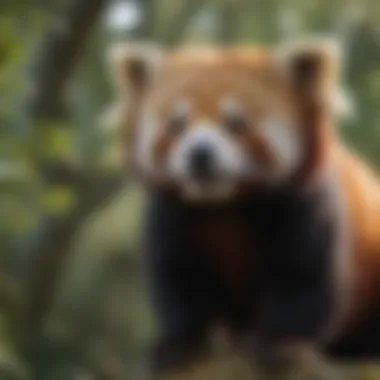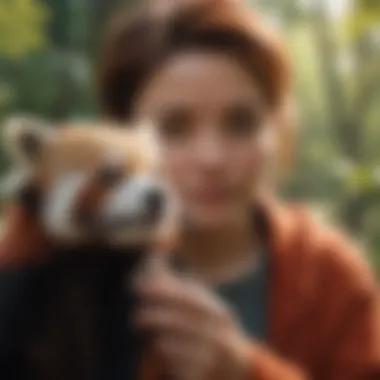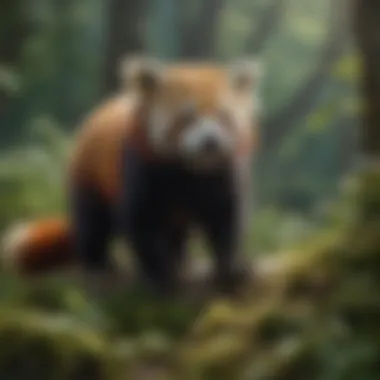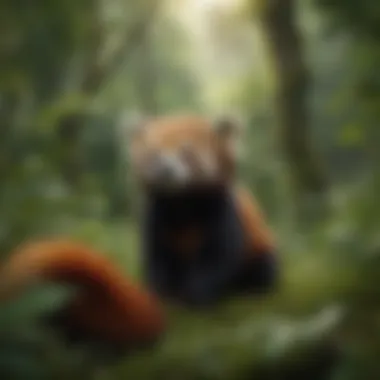Adopt a Red Panda with WWF: A Guide for Young Nature Enthusiasts


Nature Topic Overview
Adopting a red panda with WWF is an exceptional way to support wildlife and global biodiversity. Red pandas are more than just cute creatures; they play a significant role in their ecosystems. In this guide, we will embark on a journey to understand why these lovable animals matter. We will explore how adopting a red panda can make a difference.
This article speaks especially to young nature enthusiasts and their parents or caregivers. We will discuss key aspects of the red panda's life, their habitat, and the conservation efforts that focus on these animals. Engaging in conservation efforts isn’t just for grown-ups; children can embrace their roles as stewards of the environment.
Fun Facts and Trivia
Did you know that red pandas are not actually pandas? Here are a few intriguing facts about these extraordinary creatures:
- Red pandas belong to their own family called Ailuridae.
- They are more closely related to raccoons than to giant pandas.
- Red pandas can climb very well, using their sharp claws to grip trees.
These facts can inspire young minds. Incorporating visuals such as photographs of red pandas in their natural habitat can amplify engagement. Including interactive quizzes helps retain knowledge.
Wildlife Explorations
Several species inhabit the same regions as red pandas. Each plays a distinct role:
- Snow leopards – These winning big cats are vital to the Himalayan ecosystem.
- Himalayan tahr – This mountain goat is crucial in maintaining the habitat's balance.
Knowing related species creates a broader understanding of the ecosystem. Engaging content like a fun puzzle can excite young explorers about wildlife.
Environmental Awareness
Understanding conservation's importance is valuable for children. Here are some reasons why conserving red pandas matters:
- They help maintain forest health by dispersing seeds.
- Their presence indicates a rich ecosystem.
Kids can contribute to conservation. Simple actions—like recycling, conserving water, and participating in neighborhood clean-ups—go a long way.
DIY Nature Activities
Here are some hands-on activities to connect practices back to nature:
- Create a Red Panda Mask: Use paper plates and colors to decorate.
- Nature Scavenger Hunt: List items to find outdoors like leaves or interesting rocks.
- Plant a Tree: Gather seeds and plant them in a garden or pot.
These activities make learning fun. Engaging children in nature projects helps forge a real bond with the environment.
Remember, every small action contributes to a greater cause.
Understanding Red Pandas
Understanding red pandas is critical for recognizing their importance in our world and ecosystems. These charming creatures offer mehr than just cuteness; they represent a unique species that helps maintain biodiversity. By learning about their characteristics, habitat, diet, and behavior, we can effectively support conservation efforts and inspire young nature enthusiasts to nurture a keener appreciation for wildlife.
What are Red Pandas?
Red pandas, also known as Ailurus fulgens, belong to the family Ailuridae. They are not actually pandas at all. Despite the name, red pandas are more closely related to raccoons. They have a distinctive reddish-brown fur, a long bushy tail, and striking facial markings. Red pandas are relatively small, about the size of a domestic cat, which seems to add to their allure. They are known for their playful nature and can often be found climbing trees.
Habitat and Distribution
Red pandas inhabit the temperate forests of the Himalayas and mountain ranges in Nepal, India, Bhutan, and northern Myanmar. Their preferred environment includes a mix of dense bamboo thickets and old growth trees at high elevations. Young viewers might find it interesting that red pandas are mostly arboreal, meaning they spend a lot of time in trees. This habitat is essential for providing food, shelter, and safety from predators.
Diet and Behavior
When it comes to food, red pandas are specialized eaters. Their diet is primarily made up of bamboo, similar to giant pandas but red pandas eat different types of bamboo. They can consume up to 20,000 bamboo leaves each day due to bamboo's low nutritional value. Apart from bamboo, they also enjoy fruits, acorns, and occasionally insects or small rodents.
Behaviorally, red pandas are mostly solitary animals, which is interesting for children learning about gender roles in the animal kingdom. They are mostly active at night or during the twilight hours and engage in activities such as climbing, playing, and searching for food. Understanding these basic facts about red pandas provides an essential foundation for appreciating their role in biodiversity and the ecological threats they face.
The Importance of Red Pandas in Ecosystems


Red pandas and their existence have significant implications within ecosystems. Understanding their role deepens knowledge about biodiversity and underline swhy their protection matters. Red pandas are not just cute creatures; they play an essential role in their habitats. Their presence influences both plant and animal communities.
Role in Biodiversity
Biodiversity refers to the variety of life found in different habitats. Red pandas contribute to maintaining balance within their ecosystems. They are frugivores, largely eating bamboo, but they also consume fruits, berries, eggs, and insects. By helping to control the population of bamboo, they enable a diverse range of plant life to flourish. This enriches their habitat with plants that other species rely on.
Moreover, red pandas serve as prey for larger predators, which helps maintain the food web. If red pandas were to decline significantly or disappear, the entire ecosystem could suffer. Therefore, preserving a healthy population of red pandas supports various life forms that live together in their natural environments.
Indicator Species
An indicator species signals the health of an ecosystem. Red pandas are considered a vital indicator species. Their sensitivity to habitat disturbance makes it easier to monitor environmental changes. For example, when red panda numbers decrease, it shows varying issues, like deforestation and climate change affecting their habitat.
The presence of healthy red panda populations signifies that the ecosystem maintains quality in water, air, and food sources. Therefore, protecting them is not selfish; it is a necessary step toward cherishing the connected web of life in their area.
In summary, red pandas foster biodiversity within their ecosystems. Their role in food webs and dominance as indicator species highlights their importance beyond mere physical attributes. By focusing on their preservation, we pave the way for the support of upholding ecological balance.
Threats to Red Pandas
Red pandas, while appearing adorable and harmless, face numerous threats that endanger their very existence. Understanding these threats is crucial for developing effective conservation strategies. When young nature enthusiasts learn about these issues, they can better appreciate the reasons behind the WWF's red panda adoption program. By uncovering the specific challenges that these fascinating creatures confront, we foster a mindset of environmental stewardship among children and adults alike.
Habitat Loss
Red pandas inhabit dense forests, primarily in the mountainous regions of the Himalayas and southwestern China. Unfortunately, human activities such as logging and agriculture have dramatically changed their environment.
As forests continue to disappear in the quest for arable land, red pandas face a loss of protection and food sources. The fragmentation of their habitat hinders their ability to find mates, resulting in declining populations. The situation is grave.
Key Points:
- Deforestation occurs at alarming rates every year.
- Habitat fragmentation limits red pandas' movement, causing them to become isolated.
- Without urgent action, the destruction of their homes can lead to widespread extinction.
Illegal Poaching and Trade
The illegal poaching and trade of red pandas represent an ongoing and daunting threat. Poachers target these animals for their beautiful fur and the lucrative black market. Despite global conservation efforts, this illegal trade flourishes in many regions, exposing red pandas to severe risk.
Important Aspects:
- Demand for red panda pelts remains significant in some areas, but this practice is highly illegal.
- Law enforcement has been an ongoing struggle, as weak regulations often allow poaching activities to continue.
- Each red panda lost to poaching diminishes the species' chance of survival and negatively impacts the ecosystem they inhabit.
Even though poaching is illegal and harmful, it is important that children understand where it happens and why efforts must be made to protect these wonderful animals.
Climate Change Impact
Lastly, climate change is an increasing threat to red pandas. Changes in temperature and weather patterns have significant implications for their survival. As habitat conditions evolve, these animals may struggle to adapt. This is especially true for the bamboo forests, their primary food source.
By the Numbers:
- Species are being forced to move to new areas in search of food and shelter.
- Bamboo growth can decline due to altered weather patterns, leading to food shortages.
- If changes continue unchecked, certain regions of red panda habitats may become inhospitable.
Understanding these threats offers insight into the vital role that organizations like WWF play in mitigating risks faced by red pandas. By adopting a red panda, young enthusiasts contribute to important conservation efforts that address these challenges effectively.
What is the WWF's Red Panda Adoption Program?
Adopting a red panda through WWF provides an excellent opportunity to engage young nature enthusiasts in wildlife conservation. This program not only supports the protection of this endangered species, but it also encourages understanding of broader ecological issues. The WWF's commitment to red pandas goes beyond shelter; it's about educating and inspiring the next generation.
Overview of the Program
The WWF has designed its red panda adoption program to help people connect with these unique animals. When participants adopt a red panda, they actively contribute to various conservation initiatives aimed at ensuring the survival of red pandas in their natural habitat. The program outlines several important elements:
- Support for Conservation: Contributions help fund research and habitat protection to secure a future for red pandas.
- Education and Community Engagement: Participants receive materials that educate them about red pandas and environmental issues.
- Personal Connection: Adopters often learn to care about wildlife through fostering personal connections to a specific animal.


Adopters typically receive a certificate, a photo, and updates about the pandas they are supporting. This personal touch allows young learners to feel proud of their contribution to the cause.
How the Program Works
Participating in the WWF's red panda adoption program is straightforward and user-friendly. Here is a clear outline of how it functions:
- Visit the WWF Adoption Website: Interested individuals can find information and sign up on the WWF website. Here, one can choose to adopt red pandas based on different levels of support.
- Select Your Adoption: Various levels allow flexibility depending on individual or family resources. This can include basic choices or more extensive packages that provide additional educational content.
- Complete the Adoption Process: After selecting a package, participants make a donation to finalize their adoption. This financial support is critical for ongoing conservation efforts.
The program ensures regular updates about red pandas to all adopters. These updates highlight developmental changes, successes in habitats, and impact stories about contribution tof wildlife.
By engaging with the program, adopters empower WWF to continue their earnest efforts to protect our planet and its countless species of wildlife.
Benefits of Adopting a Red Panda
Adopting a red panda is not just an act of kindness; it holds many vital benefits for the animal, the environment, and the individuals involved. This initiative attracts a lot of young nature enthusiasts who can contribute to important conservation efforts and learn valuable lessons along the way. In this part, we will explore the various advantages that come with adopting a red panda through the WWF program.
Contributions to Conservation Efforts
When you adopt a red panda, the financial support helps fund critical conservation projects. These projects protect their natural habitats, ensure their survival, and work against poaching and illegal wildlife trade.
Adopting also allows for essential research. It can contribute to understanding better red panda behaviors and health. All these efforts aim to secure a sustainable future for an endangered species.
You are not just being an animal lover; you are becoming an active participant in safeguarding biodiversity. This shows a commitment to preserving habitats not only for red pandas but also for other species that share their home.
Educational Opportunities
Participation in the red panda adoption program opens doors for unique learning experiences. Young adopters get access to materials about red pandas. This includes their behaviors, their habitat, and threats they face. Through engaging resources, children learn the importance of conservation firsthand.
Educational materials often come in the form of colorful booklets, videos, and online resources. These tools help young people connect with the notion of environmental stewardship. They may engage with quizzes that make learning fun and interactive, nurturing a curiosity for nature and wildlife.
Promoting Global Awareness
Adopting a red panda fosters a sense of global connectivity among young individuals. When children adopt, the ripple effects of this action can extend to their families and communities. They become advocates for wildlife, sharing what they have learned.
Children can participate in social media campaigns or school projects aimed at raising awareness about red pandas. Such activities promote environmental responsibility around the world. They remind us of our duty to care for our planet's diverse creatures.
Steps to Adopt a Red Panda
Adopting a red panda with WWF provides young nature enthusiasts an opportunity to engage with conservation on a personal level. By following specific steps, children and their families can contribute meaningfully to the protection of this unique species. The process of adopting a red panda helps cultivate a sense of responsibility towards nature. It also raises awareness of the difficulties red pandas face in the wild. This guide provides straightforward steps to make adoption accessible and fulfilling for young advocates.
Choosing the Adoption Level
When considering adopting a red panda, it is essential to understand the various adoption levels available. Alongside financial support, each level offers distinct benefits.
- Basic Adoption: This level often provides essential info about your red panda, including its name, age, and an adoption certificate. This is a great start for individuals or families new to supporting animal conservation.
- Intermediate Adoption: This includes everything in the basic package, alongside exclusive red panda updates. This level encourages deeper engagement with the species and strong involvement.
- Full Adoption: The highest level typically offers unique bonuses, such as invitations to special events at conservation sites or guided tours. Selecting this level deeply embeds the concept of wildlife stewardship into family life.
Choosing the right level is personal, and it depends on finances and commitment to conservation. Each option brings its incentives while fulfilling the core mission of helping red pandas thrive. Knowing what each adoption level involves helps diffentiate decisions while fostering attachment to wildlife.
Completing the Adoption Process
Once you've chosen a level, completing the adoption process is straightforward. Here are the general steps involved:
- Visit the WWF Website: Go to the dedicated red panda adoption page to see details on all adoption options and their prices.
- Fill Out the Application Form: After selecting an adoption level, fill in the necessary forms. If ever confuse, clear instructions are usually provided to assist.
- Payment Process: After submission of the form, engage in the payment using secure online methods. Make sure to verify the transaction details.
- Confirmation of Adoption: Once the payment is received, confirmation materials will be sent. The excitement of seeing your contribution immediately engages children in conservation.
Adopting is an adventure more than mere paperwork. In no time, participants will become proud guardians of their chosen red panda and take part actively in protecting wildlife. By completing the adoption process, families not only support crucial conservation efforts but also lay the groundwork for lasting eco-conscious values in young people.
What Happens After Adoption?
Adopting a red panda is just the beginning of a rewarding journey. Understanding what happens after you adopt is crucial. The adoption process offers more than just a certificate; it creates a meaningful connection between individuals and wildlife conservation. Knowing what to expect helps advocates of nature enrich their experience while supporting WWF initiatives.


Receiving Adoption Materials
When you adopt a red panda, the first thing you will receive is your adoption materials. This usually includes:
- An official adoption certificate, personalized with the name of the red panda you have chosen.
- Information booklet about red pandas. This material usually contains facts about their habits, diet, and habitats.
- Photographs of your adopted panda, capturing their unique expressions and charm.
- Updates about conservation efforts and activities related to the protection of red pandas.
These materials are not just keepsakes; they serve an educational purpose as well. The booklet and photos foster a deeper understanding of these creatures. Someone can use them in school projects or share knowledge with classmates, thus further educating others about red pandas and their importance in nature.
Updates on Red Pandas
Staying connected is an essential aspect of the adoption experience. WWF provides regular updates to adopters regarding the red pandas. These updates may include:
- News on any rescue or rehabilitation efforts involving red pandas.
- Information about changes in the population of red pandas in their natural habitats.
- Details of new conservation strategies or programs being launched to protect these animals.
- Success stories showcasing how your support is making a difference.
Adopters can track how their contributions are directly impacting conservation efforts. Such insights not only encourage continued support for red panda protection but also kindle a sense of stewardship for other wildlife.
Your involvement does not stop after the initial adoption; it is an ongoing journey of learning and contributing to positive change for our world.
Through these updates, adopters develop a sense of belonging to a greater cause, knowing that their support truly reaches far and makes a difference to the beloved red panda and its environment.
How Children Can Get Involved in Conservation
Engaging children in wildlife conservation is essential because it helps foster a sense of responsibility towards nature from an early age. Understanding the importance of environmental stewardship can position kids to become informed advocates for animals like red pandas. Teaching children about various conservation topics enables them to connect emotionally with wildlife, inspiring them to participate in different initiatives. It encourages empathy and promotes community values, instilling actions that can benefit ecosystems locally and globally.
Advocacy in School Projects
Schools can be an excellent platform for young conservationists to express their interest in subjects like red pandas. Advocacy in school projects allows students to collaborate and communicate important ecological issues. Here are some ideas that might inspire young advocates:
- Class Presentations: Students can prepare presentations on red pandas, focusing on their habitats, diets, and importance to the ecosystem. This activity promotes research skills and public speaking.
- Art Projects: Creating art related to red pandas, such as drawings or crafts, can help make the topic relatable and fun. These artworks can be displayed around the school to raise awareness.
- Campaigns for Change: Initiating campaigns, like 'Save The Red Panda Day,' allows kids to share facts with their peers and fundraise for conservation organizations.
- Writing Projects: Writing essays or stories featuring red pandas can spark creativity and deepen knowledge about experiences that wildlife face.
Participation in these classroom activities gives students an outlet to voice their passion while engaging them in deeper research about conservation efforts. They learn not just about red pandas, but how their advocacy can lead to collective action.
Participating in Local Conservation Efforts
Local conservation efforts offer hands-on experiences for children, bringing their classroom learning into the real world. This participation can take various forms and greatly vary in objectives. Here are a few examples:
- Volunteering at Local Wildlife Centers: Several wildlife centers or parks focus on education and rehabilitation. Activities can range from cleaning habitats to assisting in basic care tasks. Kids learn first-hand about animal care and habitat maintenance while influencing public awareness.
- Organizing Clean-Up Events: Children can participate by helping organize or join community clean-ups at local parks. Removing trash and litter protects wildlife habitats, emphasizing the impact every individual can make.
- Joining Nature Clubs or Groups: Local nature clubs often work on projects that involve monitoring local wildlife, including red pandas. These clubs can teach about species and the challenges they face.
- Creating Educational Materials: Developing pamphlets or flyers that spread awareness about endangered animals like red pandas can be powerful. Distributing these materials in the community helps refine their message.
Engaging in local efforts creates a stronger community. Individuals learn about the interconnectedness of ecosystems and the importance of their support in broader conservation strategies. Each time children contribute, the message grows louder—every action counts.
“Children today are the advocates of tomorrow. Their youthful enthusiasm can make significant impacts in conservation efforts.”
Finale: The Value of Adoption
Adopting a red panda through the WWF is more than just a nice gesture. It is an impactful step towards conservation and involves many benefits. This process fosters a connection between children and nature. Moreover, it promotes a comprehensive understanding of wildlife and environmental stewardship. It also makes individuals feel they are part of something meaningful. This kind of involvement is crucial for building a society that values animals and their habitats.
Fostering a Connection to Nature
When children participate in the adoption program, they learn about red pandas and their habitats. This education helps them feel closer to these beautiful creatures. Knowing that there is a red panda somewhere, likely named or linked to them, creates a special bond.
Parents can use this as a teaching tool. Discussing everything from the red panda's diet to its role in the ecosystem opens conversations about nature. Learning through adoption helps spark curiosity and instills a love for wildlife. As children grow, this connection can motivate them to explore nature or pursue related careers.
“Education is not filling a bucket, but lighting a fire.”
This means that fostering a personal connection to animals can inspire children. By adopting a red panda, they gain more than basic animal facts; they become invested in the survival of the species.
Long-Term Impact on Conservation
The implications for conservation when individuals adopt a red panda are significant. The financial contributions from adoption fees support various conservation efforts. Funds often help protect habitats from deforestation or contribute to wildlife protection laws.
These actions have effects that go beyond just red pandas. Supporting global biodiversity is essential for maintaining healthy ecosystems. In operational terms, successful conservation programs bolster the environmental balance. Repairing damaged ecosystems helps ensure prosperity for all species, including humans.
Furthermore, the message spreads wider. If children and their families actively engage in wildlife conservation, this habit can extend beyond pandas. They might advocate for more endangered species. This cycle contributes to creating compassionate and informed citizens.
In summary, adopting a red panda through the WWF embodies a greater commitment beyond a single act. It contributes to raising awareness and providing crucial conservation support. By fostering a strong emotional connection with young nature enthusiasts, we pave the way for a more sustainable future for many species.







